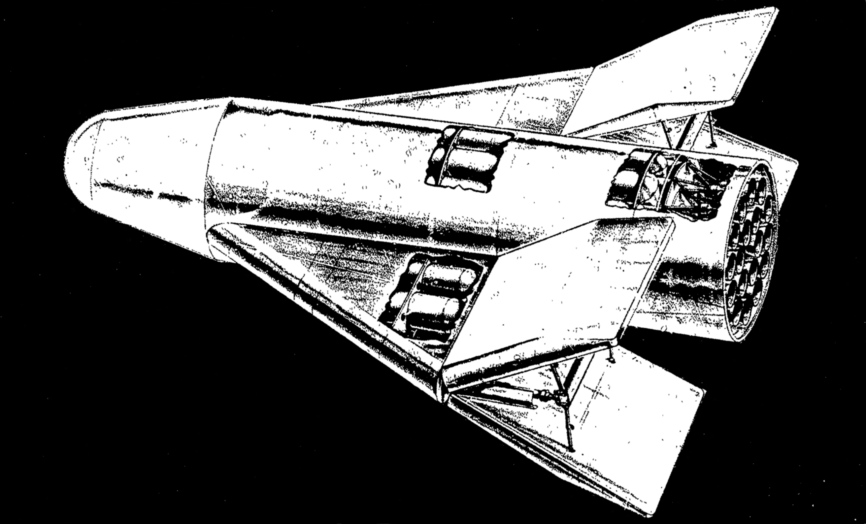Near to two years ago I posted some scraps of information about the Convair NEXUS super booster and a few of it’s gas-core nuke derivatives. At the time, I said, and I quote, “in the case of Nexus I was only able to get some surface details… the final Nexus reports have continued to elude me.” Well, them there days is done. And it only took me a dozen years! MUAHAHAHAHAHAAA!
Ahem.
Anyway, one of the designs that I had previously only seen a postage-stamp sized scrap on was a winged nuclear powered booster. Now I know it’s one of a myriad of competing concepts Convair put forward. Specifically, this was a “Helios” concept, a catch-all designation for boosters using combined chemical and nuclear propulsion. Two similar designs were put forward, one using gas-core nukes, and this one, using water moderated solid core nuclear thermal rockets. To be more precise, it employed 18 nuclear engines, each with 250,000 pounds of thrust. The fuselage diameter was a hefty 70 feet. An additional chemical booster would be attached. While not described for the solid-core concept, the variant with the gas core engine had a reasonably complete description of the chemical booster… a series of eight expansion-deflection engines of 1.34 million pounds thrust each arranged in a ring around the central nuclear engine. After burnout, the engines and their toroidal oxygen tank would fall off much like the booster engines on the original Atlas ICBM, and the vehicle would continue on to orbit under nuclear power. Payload would be one and a half million pounds.
After delivering the payload to orbit, the solid-core nuclear vehicle would lurk there for a while, waiting for the engines to cool off. Also, the trailing edge flaps would split and be locked into position. Once the engines had cooled sufficiently, the vehicle would de-orbit and essentially lawn-dart into the ocean. What looks like wings are in fact just stabilizing fins. The nature of the engines and their thrust structure at the aft of the vehicle meant that it was very tail-heavy, and required a whole lot of stabilizing. After splashdown, the ocean would serve as a heat sink for the *still* hot engines.
And as for the previously mentioned “Super NEXUS:” The payload was not delivered either to the lunar surface nor lunar orbit. Instead, the vehicle would launch from the Earth’s surface, park itself in a temporary Earth orbit, boost itself to the moon, park itself in a 20-mile altitude lunar orbit, then de-orbit to an altitude of 2000 feet, where it would hover. The payload would then separate and land itself; the Super NEXUS would then boost itself back to Earth and put itself in Earth orbit.
Easy!!
5 Responses to “NEXUS update”
Sorry, the comment form is closed at this time.

Thanks for new in side look on HELIOS/NEXUS
Sad they din’t build them
would give many radical “environmentalist”* a deadly heartattack…
* thoose how declared the Cassini spaceprobe has to be stopt,
because it would kill mankind with it nuclear powercells…
Fall into the ocean without the aid of parachutes or rockets to slow it down?
Given the weight of the reactors they would probably rip loose and go right up to the vehicle’s nose on impact.
You can see some resemblance between this booster and the one Revell put in their Helios model:
http://www.ninfinger.org/models/kitplans/revellh1829.html
I don’t remember . . . aside from the AIAA Houston thing, did you ever do a Nexus article for APR?
Not yet.
If you made it light enough, you could use that giant split dive brake technique to make a recoverable model rocket that would fall back to earth like a badminton shuttlecock.
In fact, I wouldn’t be surprised to find out that’s where Convair came up with the idea from.